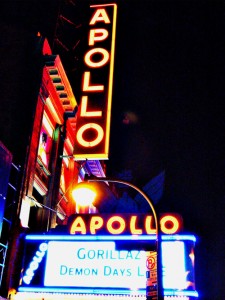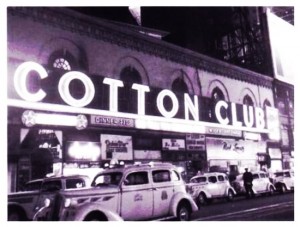The Apollo Theater:
The Apollo Theater is located at 253 West 125th Street. The theater opened in 1934 and hosted thirty-four shows per week and Amateur Night forty-five weeks a year when it first opened. The Apollo Theater became a place for African-Americans to express their culture and became the birthplace of many new forms of art and dance. Jazz was made famous because of the Apollo Theater. The Apollo audience became known for its mercilessness and cruel judgments. If the audience did not enjoy the performance, the performer would be booed off the stage. However, if the stump of the “Tree of Hope,” (a tree that once stood outside the theater where unemployed entertainers met and now its stump is rubbed by performers before they go on) gave out some luck that night, the performer would be successful. Performers such as Ella Fitzgerald and Billie Holiday performed at the Apollo during the 1930s.
During the 1940s, a new type of jazz, called bebop, came along. Bands became smaller and the focus moved away from the dance floor. Harlem’s culture thrived until 1943 when a policeman hit an African American woman who was disturbing the peace at the Braddock Hotel in Harlem. Robert Bandy, a black soldier in the army, tried to stop the police officer. The situation quickly escalated and the police officer shot Bandy in the shoulder. While Bandy was being brought to the hospital, a crowd gathered and an onlooker shouted that an African American soldier had been killed, which led to a riot, known as the Harlem Riot of 1943. Hundreds of businesses were destroyed and the property damage approached $5,000,000. Overall, six people died, 400 were injured, and 500 people were arrested. As a result, Harlem’s economic status suffered heavily. The Apollo Theater survived, but whites did not want to come to Harlem due to high crime rates and the decaying neighborhood.
The fifties brought about rhythm & blues to the Apollo Theater. During this time, Sammy Davis was a regular performer. This decade also saw the rise of the disc jockey. Next came the most radical decade, the 1960s. During this period, performers such as James Brown, Aretha Franklin, Smokey Robinson, Marvin Gaye, Stevie Wonder, the Temptations, and The Jackson Five performed at the Apollo. Huge profits came from this black pop music that spread around the world. Comedians also made a name for themselves at the Apollo, such as Bill Cosby.
All of this success at the Apollo Theater ended in the 1970s. During this time, crime and drugs overtook Harlem. In 1975, during a Smokey Robinson performance, there was a shooting in the theater that injured an eighteen year old. In January 1976, the Apollo Theater was closed. This ended an era of culture and music in Harlem. In 1983, The Apollo Theatre became a National Historic Landmark. A few years later the Apollo was redecorated and refurbished and Amateur Night was revived. Today, the audience of about 1,400 is made up of the young and old, black and white. 1
The Apollo Theater
The Cotton Club:
The Cotton Club was a famous night club in Harlem that opened in 1920. The club featured many of the greatest African American entertainers of the era such as Louis Armstrong, Duke Ellington, Dizzy Gillespie, and Billie Holiday, but it generally denied admission to blacks. The club featured these “Celebrity Nights” on Sundays. On one hand, the club reproduced the racist imagery of the times, often depicting blacks as savages. On the other hand, the club helped launch the careers of many blacks stars, including Duke Ellington and Dizzy Gillespie. In 1936, the club temporarily closed after the race riot in Harlem. It reopened in 1937 on Broadway and 48th Street. In 1989, the building was torn down and a hotel was built in its place. A new club of the same name opened on 125th Street in 1978. 2
The Cotton Club
Minton’s Playhouse:
Minton’s Playhouse is located at 205-210 West 118th Street. The venue opened in 1938 and acted as a refuge for musicians to escape from the mainstream music of the time. Many famous musicians performed here, such as Dizzy Gillespie, Hot Lips Page, Roy Elridge, and Charlie Christian. It was here that bebop was created. Unfortunately, by the 1960s very few big stars performed at Minton’s Playhouse and it was closed in the 1980s. In 2006, the venue reopened as the Uptown Lounge at Minton’s Playhouse, but it closed in 2010. 3
Minton’s Playhouse
Savoy Ballroom:
The Savoy Ballroom is located at 596 Lenox Avenue between 140th Street and 141st Street. The ballroom opened on March 12, 1926 and became the most popular dance venue in Harlem. Many of the jazz dance crazes of the 1920s and 1930s originated there, such as the Charleston and the Lindy Hop. The Savoy ballroom helped spread black culture to white America. The Lindy Hop became a dance trend in both Black and White adolescent culture throughout the 40’s, 50’s, and 60’s. The Ballroom closed in 1958 and was replaced by an apartment building. A commemorative plaque shows where the Ballroom once stood. 4
The Savoy Ballroom
1 http://www.apollotheater.org/
2 http://harlemworldblog.wordpress.com/2010/08/13/harlem-history-the-cotton-club/
3 http://www.uptownatmintons.com/?srt=1
4 http://www.savoyplaque.org/timeline.htm

 Music/Dance Venues
Music/Dance Venues 


